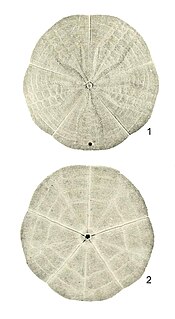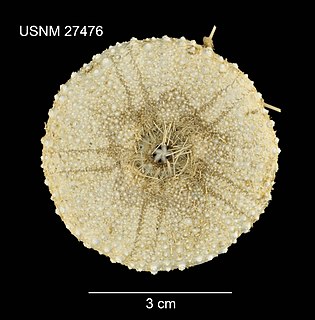Amblypneustes grandis is a species of sea urchin of the family Temnopleuridae. Their armour is covered with spines. It came from the genus Amblypneustes and lives in the sea. Amblypneustes grandis was first scientifically described in 1912 by Hubert Lyman Clark.
Ammotrophus arachnoides is a species of sand dollar of the family Arachnoididea. Their external skeleton, known as a test, is covered with spines. It belongs to the genus Ammotrophus and lives in the sea off southern Australia. Ammotrophus arachnoides was first scientifically described in 1938 by Hubert Clark.
Ammotrophus cyclius is a species of sand dollar of the family Clypeasteridae. Their external skeleton, known as a test, is covered with spines. It belongs to the genus Ammotrophus and lives in the seas off southern Australia. Ammotrophus cyclius was first scientifically described in 1928 by Hubert Clark.
Amphipneustes bifidus is a species of sea urchin of the family Temnopleuridae. Their armour is covered with spines. It is placed in the genus Amphipneustes and lives in the sea. Amphipneustes bifidus was first scientifically described in 1950 by Ole Mortensen, a Danish scientist.
Anametalia regularis is a species of sea urchin of the family Brissidae. Their armour is covered with spines. It is placed in the genus Anametalia and lives in the sea. Anametalia regularis was first scientifically described in 1925 by Hubert Clark.

Apatopygus occidentalis is a species of sea urchin of the family Apatopygidae. Their armour is covered with spines. It is placed in the genus Apatopygus and lives in the sea. Apatopygus occidentalis was first scientifically described in 1928 by Hubert Lyman Clark, American zoologist.
Aporocidaris fragilis is a species of sea urchin of the family Ctenocidaridae. It is well-armoured with spines. It is placed in the genus Aporocidaris and lives in the sea. Aporocidaris fragilis was first scientifically described in 1907 by Alexander Emanuel Agassiz & Hubert Lyman Clark.

Arachnoides tenuis is a species of sea urchin of the family Clypeasteridae. Their armour is covered with spines. It is placed in the genus Arachnoides and lives in the sea. Arachnoides tenuis was first scientifically described in 1938 by Hubert Lyman Clark.
Araeosoma eurypatum is a species of sea urchin of the family Echinothuriidae. Their armour is covered with spines. It is placed in the genus Araeosoma and lives in the sea. Araeosoma eurypatum was first scientifically described in 1909 by Alexander Agassiz and Hubert Clark.

Araeosoma leptaleum is a species of sea urchin of the family Echinothuriidae. Their armour is covered with spines. It is placed in the genus Araeosoma and lives in the sea. Araeosoma leptaleum was first scientifically described in 1909 by Alexander Emanuel Agassiz & Hubert Lyman Clark.
Araeosoma paucispinum is a species of sea urchin of the family Echinothuriidae. Their armour is covered with spines. It is placed in the genus Araeosoma and lives in the sea. Araeosoma paucispinum was first scientifically described in 1924 by Hubert Lyman Clark, an American zoologist.

Araeosoma thetidis is a species of sea urchin of the family Echinothuriidae. This species can be found in deep sea off Australia and New Zealand. A. thetidis was first scientifically described in 1909 by Hubert Lyman Clark.
Brisaster kerguelenensis is a species of sea urchins of the Family Schizasteridae. Their armour is covered with spines. Brisaster kerguelenensis was first scientifically described in 1917 by Hubert Lyman Clark.
Chaetodiadema africanum is a species of sea urchins of the Family Diadematidae. Their armour is covered with spines. Chaetodiadema africanum was first scientifically described in 1924 by Hubert Lyman Clark.

Chaetodiadema pallidum is a species of sea urchins of the Family Diadematidae. Their armour is covered with spines. Chaetodiadema pallidum was first scientifically described in 1907 by Alexander Emanuel Agassiz and Hubert Lyman Clark.
Chaetodiadema tuberculatum is a species of sea urchins of the Family Diadematidae. Their armour is covered with spines. Chaetodiadema tuberculatum was first scientifically described in 1909 by Hubert Lyman Clark.

The "raspberry sea urchin", Chondrocidaris brevispina, is a species of sea urchins of the Family Cidaridae. Their armour is covered with short, conical spines.

Clypeaster euclastus is a species of sea urchins of the Family Clypeasteridae. Their armour is covered with spines. Clypeaster euclastus was first scientifically described in 1941 by Hubert Lyman Clark.

Clypeasteridae is a family of sea urchins in the order Clypeasteroida. This family was first scientifically described in 1835 by the Swiss-American biologist Louis Agassiz.
Ammotrophus is a genus of echinoderms belonging to the family Clypeasteridae.








